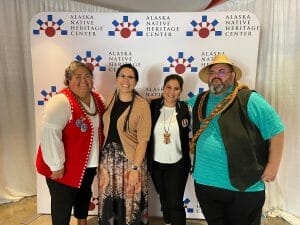
Today, Alaska Governor Mike Dunleavy signed House Bill 123, the Alaska Tribal Recognition Act – legislation that generations of Alaska Native advocates have worked tirelessly to bring about. This specific piece of legislation was sponsored by Representative Tiffany Zulkosky of Bethel and championed by Alaska Native leaders from around the state, including Sealaska’s board of directors. The bill will now pass into law, officially recognizing Alaska’s 229 tribes in a significant first step in building a positive, government-to-government relationship with the state to build a better Alaska for all.
“How can the state talk about expanding relationships with tribes when it had never taken the most fundamental basic step by recognizing them in our legal code?” said Zulkosky. “This is not just about an opportunity to work more closely in the future, it is an important first step towards healing and reconciling our past.”
Sealaska board chair Joe Nelson and fellow board members board members La quen náay Liz Medicine Crow and ‘Wáahlaal Gíidaak Barbara Blake were called upon to speak at the bill signing ceremony in their roles as cosponsors to the bill’s accompanying ballot measure.
“Today, we are acknowledging the simple fact that strong and healthy tribes are part of a strong and healthy Alaska,” said Nelson. “We are all in this together.”

“There’s exciting momentum being created in the signing of this law. I’m looking forward to what our Tribes will create with this newborn relationship with the State of Alaska” said ‘Wáahlaal Gíidaak
Alaska tribes have an immensely positive impact on the state and on the communities they serve. Tribal programs such as Indian Reservation Roads benefit not only tribal members but entire communities, providing safe and adequate transportation and public road access.
Alaska Native corporations and tribes serve many of the same constituents, serving the same mission of improving the lives of our shareholders and tribal citizens. A few common examples include:
- Supporting traditional ways of life (subsistence)
- Building sustainable rural communities through workforce development and employment
- Education
- Cultural and language preservation
- Supporting land into trust